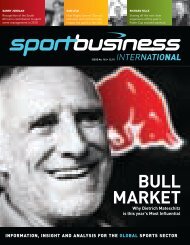4 - FIFA/CIES International University Network
4 - FIFA/CIES International University Network
4 - FIFA/CIES International University Network
You also want an ePaper? Increase the reach of your titles
YUMPU automatically turns print PDFs into web optimized ePapers that Google loves.
ANATOMY OF AN EVENT:<br />
BRITISH GRAND PRIX<br />
says Phillips, “with my boss being<br />
the BRDC - a club made of very<br />
notable racing people - we wanted<br />
to put together a design with the<br />
help of some ex-Grand Prix racers<br />
and MotoGP riders, in addition to<br />
what the fans want and of course<br />
crowd logistics.<br />
“We thought working with<br />
Populous - who were quite new to<br />
[motor racing], they’d done a bit of<br />
track design but not much - was the<br />
best thing to do because it gave us<br />
a bit more control over the creation<br />
of a really good racing circuit rather<br />
than an architectural circuit. It<br />
worked - and in addition to that<br />
we worked with our contractor<br />
Buckingham and during the<br />
construction we changed bits to<br />
make sure the racing line would<br />
be improved from the provisional<br />
plan. It’s a huge track and the plan<br />
and the actual circuit are two very<br />
different things.”<br />
It is also worth noting that the<br />
new Silverstone track layout was<br />
not initially designed with Formula<br />
One in mind but MotoGP, since<br />
the British Grand Prix was formally<br />
moved to Donington Park after<br />
the 2009 race. This played into<br />
Populous’ hands as Silverstone’s<br />
design partner, says Barrow:<br />
“Instantly we had a problem to<br />
solve, that being the motorbikes<br />
were really uncomfortable using<br />
the run through to the Bridge<br />
corner, which was the most<br />
dangerous part of the track for<br />
high-speed bike racing. A new<br />
arrangement we suggested fitted<br />
the bill so we progressed on that<br />
basis - we increased the length of<br />
the track, increased the average<br />
racing speed and created more<br />
opportunities for overtaking.”<br />
Formerly known as HOK Sport,<br />
Populous grabbed the attention<br />
of Silverstone through its costeffective<br />
plan and construction of<br />
the Dubai Autodrome race track<br />
in 2004. Barrow says the Dubai<br />
circuit was built for around half<br />
the price of others at the time and<br />
when some tracks were costing<br />
north of $300 million to construct.<br />
The whole development - which<br />
included the track, 7,000-seat<br />
grandstand and pit complex, plus<br />
a marketing and management<br />
building - cost $95 million.<br />
An important 2011<br />
“Next year is going to be a real<br />
testing point,” says Barrow,<br />
“because the Formula One start<br />
will be at Abbey, and all the new<br />
facilities will be finished by then<br />
including the four hundred metrelong<br />
pits complex and hospitality<br />
area we’ve already started building.”<br />
Redevelopments have also<br />
focused on Ecclestone’s criticism of<br />
the quality of its spectator facilities,<br />
with new elevated viewing banks<br />
under construction and existing<br />
grandstands set to be moved to<br />
bring fans closer to the action.<br />
Phillips adds that although<br />
the new track was designed<br />
with safety in mind, so too was<br />
spectator engagement a serious<br />
consideration: “We needed to<br />
engage with the public by making<br />
sure we got the grandstand heights<br />
right and the sightlines correct -<br />
getting people as close to the action<br />
as possible whilst also making sure<br />
the infrastructure behind it was<br />
right. We’ve being doing that and<br />
will be doing more in the next 12<br />
months or so and probably in the<br />
years following. This isn’t the end<br />
of the story for us at all.”<br />
However even with great<br />
investment in permanent<br />
grandstands, temporary structures<br />
at the British Grand Prix are still<br />
used in force. Silverstone’s 25-year<br />
As major events increase in scale and commercial sponsorship<br />
is restrained by lower economic growth, the public sector is fast<br />
becoming a very important funder in sport. On the government side<br />
too, there is a realisation of what sport can deliver and a willingness<br />
to invest in partnerships.<br />
The new Sport and the Role of Government report provides<br />
a roadmap for these new relationships from both sides of<br />
the table. This unique resource will help you to:<br />
l Evaluate winning partnership models based on over 40<br />
successful case studies<br />
l Strengthen the arguments for public sector investment in sport<br />
l Understand and deliver the full community benefits from sport<br />
l Gain measurement techniques across the range of public<br />
policy outcomes<br />
NEW REPORT FROM SPORTBUSINESS<br />
With interviews, academic studies and practical examples from<br />
different contexts around the world, Sport and the Role of Government<br />
will give you the tools to build powerful public-private partnerships.<br />
Sport and the Role of Government<br />
STRATEGIES FOR SUCCESSFUL PUBLIC-PRIVATE PARTNERSHIPS<br />
ORDER YOUR COPY TODAY BY VISITING: WWW.SPORTBUSINESS.COM/SPORTANDGOVERNMENT OR CALL: +44 (0) 207 954 3514

















